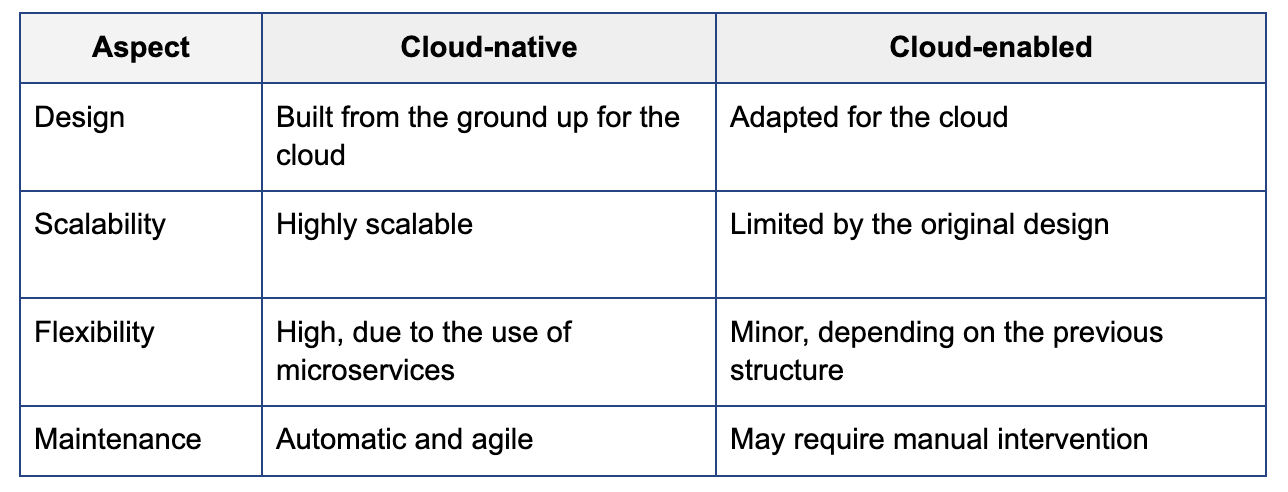
In a world where digital transformation is key to success, organizations are faced with decisions about how to migrate their operations to the cloud. Two common approaches are cloud-native development and cloud-enabled applications. What is the difference between these concepts and how do they impact business strategies?

What is Cloud-native?
Cloud-native applications are those that are specifically designed to run in cloud environments from the start. This approach involves the use of technologies such as containers, microservices, and orchestration, allowing businesses to take full advantage of the advantages of the cloud, such as scalability and flexibility.
Cloud-native systems benefit from microservices-based architecture and use modern tools such as Kubernetes for automation and resource management.
Key features of Cloud-native applications
- Deployed in containers.
- Use microservices.
- Distributed and scalable architecture.
What is Cloud-enabled?
On the other hand, a cloud-enabled application refers to a software or system originally developed to operate in on-premises environments, but which has been adapted to run in the cloud. This adaptation process allows companies to migrate their existing applications to the cloud without having to completely redesign them.
Although it allows you to take advantage of some advantages of the cloud, such as storage and processing, cloud-enabled applications do not always achieve the same efficiency and flexibility as cloud-native ones.
Key characteristics of cloud-enabled applications
- Migrated from on-premises environments to the cloud.
- Less optimized for the cloud.
- May have performance and scalability limitations.

Key differences between Cloud-native and Cloud-enabled
The most notable difference between the two approaches lies in their fundamental design. While cloud-native applications are built to maximize the benefits of the cloud from the start, cloud-enabled applications are adaptations of existing software. This leads to key differences in aspects such as performance, flexibility, and scalability.
Comparison of Cloud-native and Cloud-enabled

Advantages of adopting a Cloud-native architecture
The cloud-native approach allows companies to take full advantage of the cloud's potential. Some of the main advantages include:
- Dynamic scalability: applications can increase or decrease their capacity according to demand.
- Agile deployment: development teams can release new features quickly.
- Resilience: failures in one service do not affect the entire application, thanks to the microservices architecture.
This type of architecture is particularly useful for companies that need to remain competitive in a changing and fast-paced business environment.

Limitations of the Cloud-enabled approach
While cloud-enabled is a viable option for companies with legacy applications, it has limitations compared to the cloud-native approach:
Suboptimal performance: Cloud-enabled applications may not fully take advantage of cloud features, which impacts performance.
Less flexibility: Due to the legacy software structure, cloud-enabled applications may be more difficult to scale and modify.
Higher hardware dependency: Even though they are in the cloud, these applications still rely on certain specific hardware configurations.

When to Go Cloud-Native
The cloud-native approach is ideal for companies that are developing new applications and looking to optimize their performance and flexibility. Tech startups, for example, often opt for this approach because of their ability to bring products to market quickly and adjust to demand in real time.
Additionally, this approach is suitable for organizations that are adopting emerging technologies such as artificial intelligence and big data analytics, as these applications require high processing and storage capacity.
When to Go Cloud-Enabled
On the other hand, the cloud-enabled approach is recommended for companies that already have legacy applications and want to migrate to the cloud without completely redesigning their infrastructure. Companies with complex or highly customized systems often opt for this option, as it can be faster and cheaper than a complete rebuild.
However, it is important to recognize that this approach can be a temporary solution, as in the long term, many companies look to migrate completely to cloud-native architectures to gain the maximum benefits of the cloud.
Understanding the differences between cloud-native and cloud-enabled is essential for business leaders to make informed decisions about their cloud migration strategies. While cloud-native applications offer superior scalability and flexibility, cloud-enabled applications can be a temporary bridge to take advantage of some benefits of the cloud without a complete transformation.

